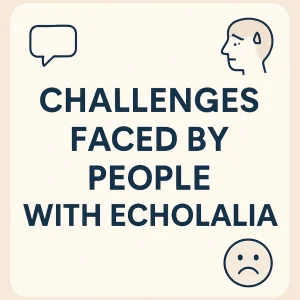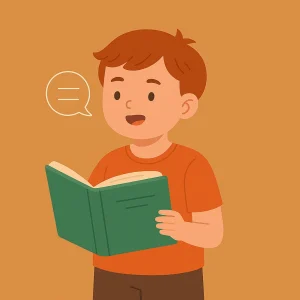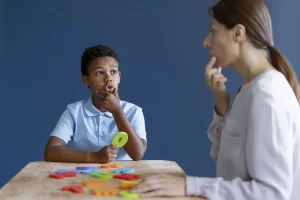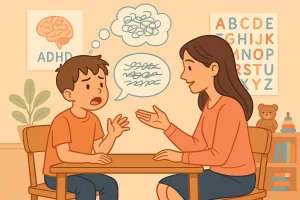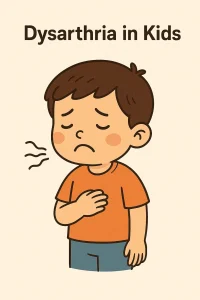Top 5 Tips for Keeping Your ADHD Child Focused and Engaged
By Rajini D
Last Updated: September 5, 2024
Keeping a child with ADHD focused and engaged can feel like a constant battle. If you’re a parent navigating this challenge, you’re certainly not alone. Many parents of children with ADHD face similar struggles, whether it’s keeping your child attentive during homework, ensuring they stay on task while reading, or just managing daily routines without distractions. The good news? With a bit of patience, creativity, and the right approach, it’s entirely possible to help your child improve their focus and stay engaged.
This article will walk you through practical, easy-to-implement tips specifically designed to keep your ADHD child focused and engaged. Remember, every child is unique. What works wonders for one child may not be as effective for another. It’s all about experimenting with different strategies and discovering what clicks for your little one. Think of it as a journey—one where small, consistent steps can lead to big improvements.
Understanding ADHD and Focus Challenges
Children with ADHD often face unique challenges when it comes to maintaining focus and staying engaged in tasks. ADHD, or Attention Deficit Hyperactivity Disorder, affects a child’s ability to concentrate, making it difficult for them to filter out distractions, stay organized, or follow through on tasks. This isn’t just about losing focus; it’s about how their brain processes information differently. For many parents, keeping an ADHD child focused can feel like a constant uphill battle, especially when traditional methods don’t seem to work.
Also read: Navigating Daily Challenges: Understanding ADHD in Adults
When you think about keeping your ADHD child focused, it’s important to understand that their struggles are not due to a lack of effort or motivation. ADHD impacts the brain’s executive functions, which are crucial for planning, prioritizing, and managing time. This means that even activities that might seem simple, like sitting down to read or finishing a puzzle, can quickly become overwhelming for a child with ADHD. Recognizing this can help you approach focus challenges with patience and empathy.
One of the first steps in helping your child is to recognize the signs when they are struggling to maintain focus. This can include frequent daydreaming, jumping from one task to another without completing them, or becoming easily frustrated with activities that require sustained attention. If you notice these signs, it might be time to try some attention tips specifically designed for kids with ADHD.
Understanding these behaviors is key to keeping your ADHD child focused. It’s not about forcing them to fit into a typical mold; rather, it’s about finding strategies that align with their way of thinking and learning. This means creating a supportive environment that caters to their needs, using tools and techniques that can help enhance their concentration and engagement. For example, using visual cues, breaking tasks into smaller parts, or incorporating movement into activities are all effective ways to keep ADHD children engaged.
Tip 1: Incorporate Movement During Tasks
One of the most effective ways to boost attention in ADHD kids is by incorporating movement into their activities. For children with ADHD, sitting still and focusing can be a significant challenge, but adding some physical activity can make a world of difference. Movement not only keeps them engaged but also helps improve concentration by channeling their energy in a positive direction.
Here are some practical ADHD focus tips for kids that involve movement:
- Follow Words with a Finger: While reading, encourage your child to use their finger to follow along with the text. This small movement keeps their hands busy and helps them stay engaged with what they’re reading. It’s a straightforward yet effective way to maintain focus without requiring any special tools.
- Use a Stress Ball or Fidget Toy: Giving your child a stress ball or a small fidget toy can keep their hands busy while their mind is focused on the task at hand. This can be particularly helpful during activities that require sitting still, like reading or doing homework. The subtle, repetitive motion helps them stay grounded and attentive.
- Active Sitting: If your child struggles to sit still, consider using a yoga ball or a wobble chair instead of a traditional chair. These seating options allow for gentle movement, which can help your child maintain focus without feeling confined.
- Incorporate Short Breaks: Let your child take short movement breaks between tasks or reading sessions. Even a quick walk around the room, some light stretching, or a few jumping jacks can reset their focus and prevent burnout.
- Chewing Gum or Eating a Healthy Snack: Simple actions like chewing gum or eating a small, healthy snack can also keep an ADHD child engaged. It provides an additional sensory input that can aid concentration without being overly distracting.
Tip 2: Encourage Reading Out Loud
When your child reads out loud, they’re not just looking at words—they’re actively involved in understanding what they’re reading. This is especially helpful for kids with ADHD, who often struggle to stay focused with silent reading.
Reading out loud makes the brain slow down and pay attention to each word. This can reduce distractions and help your child remember what they read better. If you’re asking, “How can I help my ADHD child stay engaged?” reading aloud is a great place to start.
Here are some easy ways to include reading out loud in your child’s routine:
- Make It a Shared Activity: Reading doesn’t have to be done alone. Your child can read to you, a sibling, or even a pet. This makes reading more fun and helps them feel supported. You can take turns reading, which keeps it interactive and less overwhelming.
- Ask Questions and Discuss: While reading, pause now and then to ask your child questions about the story. This keeps them involved and thinking about what they’re reading, not just focusing on the act of reading. Ask what they think will happen next or how a character might feel. This approach not only helps them understand better but also makes reading more engaging.
- Choose Books They Like: Let your child pick books they’re interested in, like stories about superheroes, animals, or their favorite hobbies. When kids are excited about the topic, they’re more likely to stay focused. Make trips to the library or bookstore fun and let them choose what they want to read.
- Celebrate Progress: Always acknowledge your child’s efforts, no matter how small. Whether they read a paragraph without losing focus or say a tricky word correctly, positive feedback is important. It boosts their confidence and encourages them to keep going.
Tip 3: Allow for Doodling and Drawing
Keeping kids with ADHD focused can be tricky, especially during reading or studying. One easy way to help is by letting them doodle and draw. It might sound surprising, but doodling can actually help them pay attention and stop their minds from wandering.
Doodling isn’t just scribbling—it’s a way to keep their brain active just enough to stay focused. Research shows that doodling can improve concentration by using a small amount of mental effort to prevent daydreaming. For kids with ADHD, this can make a big difference.
Here are some simple ways to include doodling and drawing in your child’s routine to help them stay focused:
- Draw Symbols Next to Important Text: If your child is reading or studying, encourage them to draw small symbols next to important parts. For example, they can draw a smiley face next to a character they like or a light bulb by a key idea. This makes reading more fun and helps them remember details later.
- Use Sticky Notes for Important Sections: Sticky notes are a great tool for kids with ADHD. They can use them to mark important sections, jot down quick thoughts, or doodle something related to what they’re reading. This makes reading more active and keeps them engaged.
- Doodle During Breaks: Let your child take short doodling breaks between reading or studying. This can be a fun way to express their thoughts and refresh their focus. Just a few minutes of drawing can help them get back to their work with better attention.
- Visual Storytelling: If your child is creative, ask them to draw scenes from a book they’re reading or illustrate ideas from their studies. This not only helps them focus but also makes learning more fun by connecting pictures with what they’re reading.
- Keep It Fun and Pressure-Free: The key is to keep doodling light and enjoyable. It’s not about making perfect drawings; it’s about giving your child a way to stay engaged. Let them experiment and use doodling as a helpful tool, not a strict task.
Tip 4: Introduce Multi-Tasking Activities
When it comes to focus strategies for ADHD children, introducing multi-tasking activities might seem counterintuitive. However, certain types of multi-tasking can actually help maintain focus and keep your child engaged. By combining physical movement or sensory activities with tasks like reading or studying, you can provide the additional stimulation that kids with ADHD often need to stay attentive.
You might be wondering, “What strategies work to improve focus in kids with ADHD?” One effective approach is to allow controlled multi-tasking, where your child can engage in a simple, secondary activity that doesn’t detract from the primary task. For example, listening to soft background music or chewing gum can provide the right level of sensory input, helping to keep their minds from wandering.
Here are some multi-tasking activities that can help your ADHD child maintain focus:
- Listening to Music: Soft, instrumental music or nature sounds can provide a soothing backdrop that helps your child concentrate on reading or studying. The rhythmic sound can act as a gentle anchor, keeping their thoughts from drifting too far. Just make sure the volume is low and that the music isn’t too distracting—lyrics, for instance, might pull focus away from the task at hand.
- Chewing Gum or Eating a Snack: Chewing gum or munching on a small, healthy snack can keep your child’s mouth and mind engaged. This simple action provides sensory input that can help your child stay alert and focused, especially during tasks that require sitting still.
- Fidgeting with a Stress Ball or Fidget Spinner: Allowing your child to fidget with a stress ball, fidget spinner, or another small toy can give their hands something to do while their mind focuses on learning. This form of multi-tasking helps channel excess energy that might otherwise lead to restlessness or distraction.
- Using a Standing Desk or Balance Ball: Instead of sitting in a traditional chair, let your child use a standing desk or sit on a balance ball. This setup encourages gentle movement and can improve focus by keeping your child’s body engaged without overwhelming their senses.
- Walking or Pacing While Learning: If your child finds it hard to sit still, let them walk around or pace back and forth while reading or memorizing information. This movement can help them retain information better, making the learning process more dynamic and less monotonous.
- Holding a Small Object or Toy: Sometimes, holding a small object or toy in hand, like a smooth stone or a soft plush, can provide a comforting distraction that helps your child focus on the main task. It’s a subtle way to incorporate movement and sensory input without pulling too much attention away from what they’re doing.
Multi-Tasking Activities for ADHD Focus
| Activity | Purpose | How to Implement |
|---|---|---|
| Listening to Music | Provides a soothing background that enhances focus by reducing environmental distractions. | Select soft, instrumental music without lyrics. Keep the volume low to ensure it doesn’t become a distraction. Use music apps that offer playlists designed for concentration, such as classical or nature sounds. |
| Chewing Gum | Keeps the mouth engaged, which can help maintain concentration by providing a repetitive, calming motion. | Offer sugar-free gum during tasks that require focus. Ensure the gum is non-distracting and does not interfere with the task at hand. This can be particularly helpful during homework or reading sessions. |
| Fidgeting with a Toy | Occupies the hands with simple, repetitive movements, which can help sustain attention by channeling restless energy. | Provide your child with a small, quiet fidget toy, like a stress ball, fidget spinner, or putty. Encourage its use during activities where sitting still is required, like during reading or study time. |
| Using a Balance Ball | Encourages gentle, continuous movement that helps maintain focus by engaging the body in a way that is not distracting. | Replace the traditional chair with a balance ball or a wobble chair. The subtle movement keeps the body active while allowing the child to stay seated and focused on the task, whether it’s writing or drawing. |
| Walking While Learning | Facilitates memorization and engagement by combining physical movement with cognitive tasks, which can help improve focus and retention. | Allow your child to walk or pace around the room while reading aloud, memorizing information, or thinking through problems. This approach helps in releasing excess energy and aids in better absorption of the material. |
Tip 5: Make Reading an Interactive Activity
Engaging children with ADHD during reading can be a challenge, but turning reading into an interactive activity can make a significant difference. By actively involving your child in the process, you can help them stay focused and make the experience more enjoyable. Here are some ADHD child concentration tips to make reading sessions more interactive and effective.
1. Ask Questions During Reading
One of the top techniques to help ADHD children stay focused is to ask questions while reading together. Instead of simply reading through a passage, pause occasionally to ask your child what they think about the story, what might happen next, or how they feel about a character’s actions. These questions keep them engaged and encourage them to think critically about the text. It also transforms reading from a passive activity into a conversation, making it easier for your child to stay involved.
2. Search for Keywords and Important Details
To maintain focus, encourage your child to search for keywords or important details within the text. This can be as simple as finding words in bold or underlined sections, or identifying main ideas in a paragraph. You can even turn it into a game by timing them to find specific words or concepts. This strategy not only keeps them engaged but also helps improve their comprehension and retention of the material.
3. Keep Reading Sessions Short and Sweet
Children with ADHD often struggle with long periods of concentration, so it’s important to keep reading sessions brief. Instead of long, uninterrupted reading, break the session into shorter chunks with small breaks in between. This helps prevent fatigue and keeps the experience positive. You can gradually extend the time as your child’s focus improves, but always keep an eye on their energy and engagement levels.
4. Incorporate Free-Choice Reading Time
Allowing your child to choose what they read can greatly enhance their interest and focus. Whether it’s comic books, magazines, or a story about their favorite topic, giving them the freedom to pick their own reading material empowers them and makes reading feel less like a chore. Free-choice reading can be a great way to build a habit of reading without the pressure, making it a more enjoyable part of their routine.
5. Use Interactive Tools
Interactive tools like highlighting pens, sticky notes, or digital reading apps that allow for annotations can further engage your child during reading. Encourage them to highlight interesting parts, jot down their thoughts, or draw symbols next to key points. This not only makes reading more engaging but also reinforces their understanding of the content.
Conclusion
Helping a child with ADHD stay focused and engaged can be a journey filled with trial and error, but you’re not alone. We’ve covered various strategies, like adding movement, trying multi-tasking, making reading more interactive, and celebrating small wins. Each tip is aimed at keeping your ADHD child focused in ways that suit their unique needs. Remember, every child is different, and it might take some time to find what works best. Be patient, stay flexible, and don’t give up if a strategy doesn’t work immediately. It’s all about finding the right fit and making small adjustments along the way.
It’s also important to involve your child in this process and be open to trying new methods. Celebrate their efforts, even the small ones, and keep things positive. Consistency and positive reinforcement can make a big difference over time, building your child’s confidence and ability to focus. For more personalized advice or extra support, consider reaching out to professionals at Wellness Hub. We’re here to provide the guidance and resources you need to help your child succeed. Remember, progress is the goal—not perfection. With the right approach, you can help your child grow, learn, and thrive.
Frequently Asked Questions:
1. How can I help my ADHD child stay focused on tasks?
To help your ADHD child stay focused, try incorporating movement, like letting them use a stress ball or walk around while working. Break tasks into smaller chunks, use interactive reading methods, and celebrate small achievements to keep them motivated and engaged.
2. What are effective ways to boost attention in ADHD kids?
Effective ways to boost attention in ADHD kids include using multi-tasking activities like listening to soft music, chewing gum, or using a fidget toy. These activities can provide the right amount of sensory input to help them concentrate better on their tasks.
3. What strategies work to improve focus in kids with ADHD?
Strategies that work to improve focus in kids with ADHD include making tasks interactive, such as asking questions while reading, searching for keywords, and allowing doodling. Keeping sessions short and allowing breaks can also help maintain their attention.
4. How does reading out loud help children with ADHD?
Reading out loud helps children with ADHD by engaging multiple senses at once, which improves focus and comprehension. It also turns reading into an active task, making it easier for them to stay engaged with the material.
5. Why is consistency important for ADHD children?
Consistency is important for ADHD children because it provides a predictable routine that reduces anxiety and helps them know what to expect. Regular schedules and consistent approaches to tasks can improve their ability to stay focused and complete activities.
6. What are some simple strategies to improve focus in ADHD kids during reading?
Simple strategies to improve focus during reading include allowing your child to doodle, use sticky notes to mark important sections, or highlight key words. These activities make reading more interactive and help keep their attention on the material.
7. How can positive reinforcement help my ADHD child?
Positive reinforcement helps by encouraging your child to keep trying and recognizing their efforts. Celebrating small wins, like staying focused for a short period, can build their confidence and motivate them to keep improving.
8. What are some ADHD child concentration tips for homework and studying?
For homework and studying, allow movement by using a standing desk or balance ball, provide short breaks, and use tools like timers to keep tasks manageable. Encouraging your child to set small goals and offering praise for their efforts can also help maintain their focus.
9. How can I track my ADHD child’s progress without making it stressful?
You can track progress by using a simple chart, checklist, or sticker system to mark completed tasks and small successes. Keep it positive and low-pressure, focusing on improvement rather than perfection, and adjust strategies as needed based on what works best.
10. Where can I find more support for managing my child’s ADHD?
For more personalized advice or additional support, consider reaching out to professionals at Wellness Hub. They offer tailored guidance and resources to help parents and children manage ADHD effectively.
About the Author:
Rajini Darugupally
M.Sc., Speech-Language Pathologist (9+ years of experience)
Rajini is a passionate and dedicated Speech-Language Pathologist with over 9+ years of experience, specializing in both developmental speech and language disorders in children and rehabilitation in adults. Driven by a desire to empower each individual to find their voice, Rajini brings a wealth of experience and a warm, genuine approach to therapy. Currently, at Wellness Hub, she thrives in a team environment that values innovation, compassion, and achieving results for their clients.
Book your Free Consultation Today
Parent/Caregiver Info:
Client’s Details:
* Error Message

